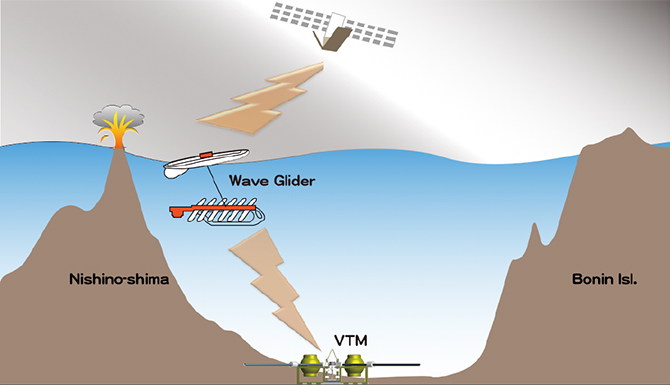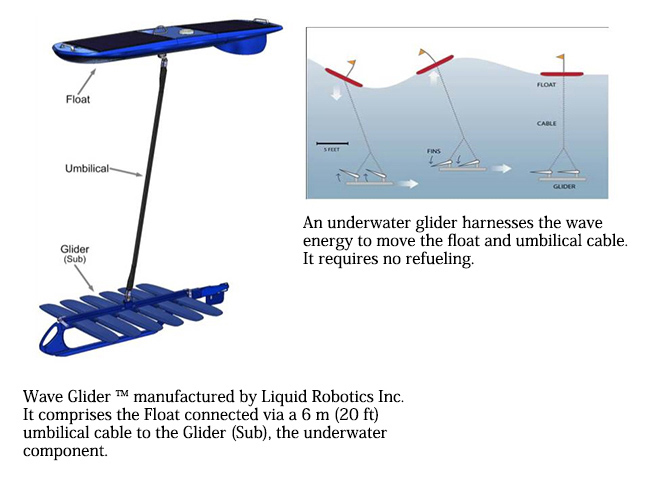Press Releases
March 27, 2015
JAMSTEC
Earthquake Research Institute,
The University of Tokyo
Graduate School of Science, Faculty of Science,
Kyoto University
First Scientific Research by Ocean Research Vessel
at Nishinoshima Volcano since November 2013
~Established Observation System for Volcanic Activity, Earthquakes and Tsunamis
with Topographic Research, Infrasonic Observations and Video Filming~
Overview
A research team formed by the Japan Agency for Marine-Earth Science and Technology (JAMSTEC: President Asahiko Taira), Earthquake Research Institute at The University of Tokyo and Graduate School of Science, Faculty of Science at Kyoto University carried out scientific research on volcanic activity at Nishinoshima around its sea areas (more than 6km away from Nishinoshima) using a research vessel for the first time since the volcanic eruptions in November 2013*.
To observe micro-tsunamis with collapse of the slopes of Nishinoshima volcano, one SeaFloor ElectroMagnetic Station (SFEMS) with a differential pressure gauge and five Ocean Bottom Seismographs were deployed (figure 1). In addition, the team stayed the surrounding sea area of Nishinoshima for two days and could understand the overview of the continued volcanism through topographic researches, infrasonic and visual observations and video filming (figure 2).
Comparison of these observation data of the 6km zone with infrasonic observations at Chichi-jima 130km away from Nishinoshima, which has been carried out by The University of Tokyo, will now enable us to understand activity at Nishinoshima on a constant basis.
*JAMSTEC Kairei Cruise KR15-03
Period: February 20th – March 1st, 2015
Chief Scientist: Hiroaki Toh, Associate Professor at Kyoto University
A total of eight scientists onboard:JAMSTEC (Yozo Hamano, Yuko Sugioka, Aki Ito), Earthquake Research Institute, The University of Tokyo (Mie Ichihara, Hideji Abe), Graduate School of Science, Faculty of Science, Kyoto University (Hiroaki Toh, Issei Kawashima, Koudai Iwashita)

Figure1: Research result of Nishinoshima topography with OBS and SFEMS sites.

Figure 2: Eruptions at Nishinoshima (photo by Hideji Abe, Earthquake Research Institute,The University of Tokyo)

Figure3: SFEMS(a) and OBS(b) are deployed from the vessel.

Figure 4: Images(a-f) obtained at a location 6km away from Nishinoshima during cruise. As shown below, similar infrasonic waves were confirmed also at Chichi-jima, 130km away from Nishinoshima (photo by Hideji Abe, Earthquake Research Institute,The University of Tokyo).

【Reference 1】Real-time observation system using Vector TsunaMeter (VTM)

【Reference 2】Wave GliderTM(WG)
【Refernce 3】Real-time Ocean Bottom Tsunami Monitoring System Using Vector TsunaMeter Successfully Completes Trial Observation (reported on April 1, 2014)
Eruption at Nishinoshima (filmed on February 27, 2015)
Contacts:
- (For volcanic activity in Nishinoshima)
The University of Tokyo - Outreach and Public Relation Office, Earthquake Research Institute
- JAMSTEC
- Hiroko Sugioka, Senior Scientist, Department of Deep Earth Structure and Dynamic Research
- (For SFEMS)
Kyoto University - Hiroaki Toh, Associate Professor, Graduate School of Science, Faculty of Science
- JAMSTEC
- Yozo Hamano, Special Senior Scientist, Department of Deep Earth Structure and Dynamic Research
- (For press release)
JAMSTEC - Kazushige Kikuchi, Manager, Press Division, Public Relations Department
- The University of Tokyo
- Outreach and Public Relation Office, Earthquake Research Institute
- Kyoto University
- Kenji Endo, Public Relations, External Affairs Department